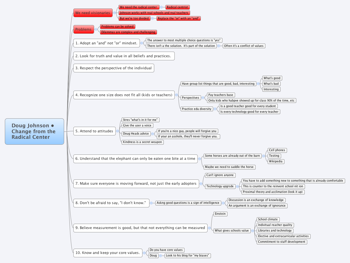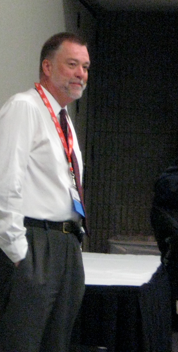 So why am I posting so many reflections on this year’s ISTE in Denver. The best answer I can come up with is my iPad. That’s not entirely true. It probably has much more to do with how I was taking notes on my iPad, using mind mapping software (see Taking Nots on the iPad). I started with SimpleMind, but migrated over to MindPad because I was constantly having to rearrange the nodes into a layout that made sense. This was not necessarily a bad thing, because it gave me something to do during lulls in the presentation. But I ended out using MindPad.
So why am I posting so many reflections on this year’s ISTE in Denver. The best answer I can come up with is my iPad. That’s not entirely true. It probably has much more to do with how I was taking notes on my iPad, using mind mapping software (see Taking Nots on the iPad). I started with SimpleMind, but migrated over to MindPad because I was constantly having to rearrange the nodes into a layout that made sense. This was not necessarily a bad thing, because it gave me something to do during lulls in the presentation. But I ended out using MindPad.
Since the conference, I’ve taken another look at iThoughtsHD and although its interface is a little less smooth, it has more functionality and exports to a slew of other applications and in a number of ways, including WiFi.
The practical affect for me is that I have a set of distinct notes organized logically, that take me back to the presentation rooms rooms and in front of the speakers. This is preferable to the hodgepodge of notes written down on a note pad, either analog or digital, requiring careful interpretation later on. To the right are my notes for Doug Johnson’s presentation, exported to my MacBook Pro via WiFi and imported into XMind.
Of course ISTE (formerly known as NECC) is a place where smart people go to learn. But it is also the place were we go to care about their own ideas. There are proclamations, exaltations, disagreements, confusion, support for some approaches and recrimination of others. People are made to feel good and made to feel bad because of what they think and sometimes because of how they’ve spent their money. Interactive White Boards are an obvious current example, as many (myself included) are weary of the technology because of its evident support and potential perpetuation of teacher-centered classrooms.
And then comes Doug Johnson’s Change from the Radical Center. Author of the Blue Skunk Blog (one of my favorites) and a range of books for teachers and librarians, Doug brings a practical and mature approach to modernizing our schools, classrooms, and libraries. In his online handouts, Johnson writes…
While polarized views of reading methodologies, filtering, DRM, Open Source, copyright/copyleft, constructivism, e- books, computer labs, fixed schedules, Mac/PC/Linux, and the One Laptop Per Child project all make for entertaining reading and a raised blood pressure, radical stances rarely create educational change or impact educational institutions enough to change kids’ chances of success.
With his Minnesota humor (and no mention of Ollie), Doug compellingly suggests ten principals to follow to cut through the passions of heart-felt beliefs to approaches that may succeed in affecting positive change in our classrooms and libraries. You can read them all here. I’m going to comment on just a few.
 |
|
I had to reach all the way back to NECC 2007 to find this picture of Doug |
One of the first cut through much of the controversial proclamations made in the presentation rooms and during hall and lounge conversations that I witnessed and participated in. He suggests that we “Adopt an ‘and’ not ‘or’ mindset.” I feel pretty strongly that every student should be walking into their classrooms with computers under their arms. I’m increasingly convinced of the power of focused backchanneling during presentations (lectures) and conversations. But this does not mean that students should have their laptops out every minute of the school day, chatting with each other about what the teacher or a classmate is saying. There is room for laptops open and for laptops closed. There is room for lower end Netbooks for the lion’s share of the learning work, and a garden of high-end work stations in the media center for video productions and data visualization.
Johnson also advocated that we look for the truth and value in all of our perspectives and practices. Because someone says or promotes something that appears objectionable to me our you, doesn’t mean that it is all worthy of objection. Find the value and work with that.
Another one that resonated with me was being comfortable saying, “I don’t know.” I think this is important, because it embraces the fact that we are all learning. When I give myself permission to say, “I don’t know,” then I’m give those around me comfort with what they do not yet know — but will learn.
The one that I continue to struggle with was, “Understand that the elephant can only be eaten one bite at a time.” First of all, I’m not to keen on eating elephant. It probably does not taste like chicken. But I fear that the luxury of “small steps” is more than we can afford. I don’t know if our children have the time for their educators to take their time in adopting more contemporary approaches to teaching. How many more years are we going to excuse ourselves as immigrants?
How many more students are going to graduate, perfectly prepared for the 1950s?

Hi Dave,
Thanks for the great write up. I am truly humbled when someone with your fine reputation attends a session.
The “one bite (step) at a time” is problem for many who advocate for change. I’ve noticed in my own district that while the any one year seems little changed from the previous, over the course of several years big things have been accomplished. I am always happier with the small wins than the big losses 😉
Oh, and I think elephant tastes more like goat myself.
Thanks again,
Doug
About six months ago I wrote a blog post and the title was something like Keep Up or Get Out of My Way. I was tired of teachers who complained because I was so far ahead of where they were concerning my use of technology in my classroom. I was even more frustrated when it was suggested that I had learned enough and could take a break from learning for a while because it isn’t “fair” to the students at my school to have one teacher integrating technology while the others are just getting started. Here we are six months later and I have still not figured that one out.
I have been nothing but willing to help train the people I work with, but for two years now I have heard over and over again how there is no time. If schools do not schedule training to help teachers implement technology and web tools then it will never happen. Unfortunately, for many teachers their day begins at 8 and ends at 3:30 and they don’t think of anything related to education outside of those hours. A common strategy seems to be to learn one tool a year. It’s disappointing that some of my colleagues don’t think enough of themselves to do more than that. I am not saying that teachers have to master everything out there, but as a whole, we need to step up and start taking on the responsibility of learning on our own so we can meet our students in the world in which they live.
It’s got to be hard, working in a school where you’re one of the only progressive teachers. I’ve heard lots of horror stories, like yours. It got to be what would be so wonderful about working in a school like Science Leadership Academy, where all of the teachers were hired because the are constantly learning and progressing.
Two things bothered me about your comment. First, the suggestion that, as a teacher, you were learning too much, that the learning stops when you start to teach. And the second was the idea of time. I know that time is a huge problem, that teachers still work in an assembly line model, in production for nearly the entire shift. But there seems to be no concern about time and our students. How much time do they have. For how many years are we going to continue to graduate children perfectly suited for the 1950s.
It’s not like they can wait any longer…